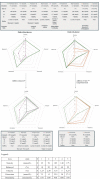How to follow the guidelines, when the appropriate fluid is missing?
- PMID: 38498239
- PMCID: PMC11098858
- DOI: 10.1007/s00431-024-05514-6
How to follow the guidelines, when the appropriate fluid is missing?
Abstract
Intravenous maintenance fluid therapy (IV-MFT) is probably the most prescribed drug in paediatric hospital care. Recently paediatric societies have produced evidence-based practice guidelines that recommend the use of balanced isotonic fluid when prescribing IV-MFT in both acute and critical paediatric care. Unfortunately, the applicability of these guidelines could be called into question when a ready-to-use glucose-containing balanced isotonic fluid is not available. The main objective of this study was to describe the availability of glucose-containing balanced isotonic fluids in European and Middle Eastern paediatric acute and critical care settings. This work is an ancillary study of the survey dedicated to IV-MFT practices in the paediatric acute and critical care settings in Europe and Middle East, a cross-sectional electronic 27-item survey, emailed in April-May 2021 to paediatric critical care physicians across 34 European and Middle East countries. The survey was developed by an expert multi-professional panel within the European Society of Peadiatric and Neonatal Intensive Care (ESPNIC). Balanced isotonic fluid with glucose 5% was available for only 32/153 (21%) responders. Balanced isotonic fluid with glucose 5% was consistently available in the UK (90%) but not available in France, Greece, The Netherlands and Turkey. Conclusion: Ready-to-use isotonic balanced IV solutions containing glucose in sufficient amount exist but are inconsistently available throughout Europe. National and European Medication Safety Incentives should guarantee the availability of the most appropriate and safest IV-MFT solution for all children. What is Known: • Intravenous maintenance fluid therapy (IV-MFT) is probably the most prescribed drug in paediatric hospital care. • Balanced isotonic fluid is recommended when prescribing IV-MFT in both acute and critical paediatric care. What is New: • Balanced isotonic fluid with glucose 5% is available for less than 25% of the prescribers in Europe and the Middle East. Availability of balanced isotonic fluid with glucose 5% varies from one country to another but can also be inconsistent within the same country. • Clinicians who have access to a ready-to-use balanced isotonic fluid with glucose 5% are more likely to consider its use than clinicians who do not have access to such an IV solution.
Keywords: Balanced fluids; Intravenous fluids; Isotonic fluids.
© 2024. The Author(s).
Conflict of interest statement
DWB and IG received honoraria for presentations from BBraun. LNT received honoraria for presentations from Nestle. FVV received honoraria for presentations from Baxter, Nutricia and Nestle Health Care. For the remaining authors, none was declared.
Figures

References
-
- Brossier DW, Tume LN, Briant AR, Jotterand Chaparro C, Moullet C, Rooze S, et al. ESPNIC clinical practice guidelines: intravenous maintenance fluid therapy in acute and critically ill children— a systematic review and meta-analysis. Intensive Care Med. 2022;48(12):1691–1708. doi: 10.1007/s00134-022-06882-z. - DOI - PMC - PubMed
MeSH terms
LinkOut - more resources
Full Text Sources
Miscellaneous

